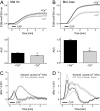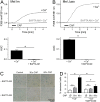Cold atmospheric plasma causes a calcium influx in melanoma cells triggering CAP-induced senescence
- PMID: 29968804
- PMCID: PMC6030087
- DOI: 10.1038/s41598-018-28443-5
Cold atmospheric plasma causes a calcium influx in melanoma cells triggering CAP-induced senescence
Abstract
Cold atmospheric plasma (CAP) is a promising approach in anti-cancer therapy, eliminating cancer cells with high selectivity. However, the molecular mechanisms of CAP action are poorly understood. In this study, we investigated CAP effects on calcium homeostasis in melanoma cells. We observed increased cytoplasmic calcium after CAP treatment, which also occurred in the absence of extracellular calcium, indicating the majority of the calcium increase originates from intracellular stores. Application of previously CAP-exposed extracellular solutions also induced cytoplasmic calcium elevations. A substantial fraction of this effect remained when the application was delayed for one hour, indicating the chemical stability of the activating agent(s). Addition of ryanodine and cyclosporin A indicate the involvement of the endoplasmatic reticulum and the mitochondria. Inhibition of the cytoplasmic calcium elevation by the intracellular chelator BAPTA blocked CAP-induced senescence. This finding helps to understand the molecular influence and the mode of action of CAP on tumor cells.
Conflict of interest statement
The authors declare no competing interests.
Figures





Similar articles
-
Cold atmospheric plasma, a new strategy to induce senescence in melanoma cells.Exp Dermatol. 2013 Apr;22(4):284-9. doi: 10.1111/exd.12127. Exp Dermatol. 2013. PMID: 23528215
-
Acidified Nitrite Contributes to the Antitumor Effect of Cold Atmospheric Plasma on Melanoma Cells.Int J Mol Sci. 2021 Apr 4;22(7):3757. doi: 10.3390/ijms22073757. Int J Mol Sci. 2021. PMID: 33916572 Free PMC article.
-
Roles of intracellular and extracellular ROS formation in apoptosis induced by cold atmospheric helium plasma and X-irradiation in the presence of sulfasalazine.Free Radic Biol Med. 2018 Dec;129:537-547. doi: 10.1016/j.freeradbiomed.2018.10.434. Epub 2018 Oct 21. Free Radic Biol Med. 2018. PMID: 30355525
-
Synergistic effects of cold atmospheric plasma and doxorubicin on melanoma: A systematic review and meta-analysis.Sci Rep. 2025 Mar 6;15(1):7870. doi: 10.1038/s41598-025-90508-z. Sci Rep. 2025. PMID: 40050300 Free PMC article.
-
Cold atmospheric plasma, a novel promising anti-cancer treatment modality.Oncotarget. 2017 Feb 28;8(9):15977-15995. doi: 10.18632/oncotarget.13304. Oncotarget. 2017. PMID: 27845910 Free PMC article. Review.
Cited by
-
Cold Atmospheric Plasma: A New Strategy Based Primarily on Oxidative Stress for Osteosarcoma Therapy.J Clin Med. 2021 Feb 23;10(4):893. doi: 10.3390/jcm10040893. J Clin Med. 2021. PMID: 33672274 Free PMC article. Review.
-
Selective adhesion inhibition and hyaluronan envelope reduction of dermal tumor cells by cold plasma-activated medium.Cell Adh Migr. 2023 Dec;17(1):1-19. doi: 10.1080/19336918.2023.2260642. Epub 2023 Sep 24. Cell Adh Migr. 2023. PMID: 37743639 Free PMC article.
-
Molecular Mechanisms of the Efficacy of Cold Atmospheric Pressure Plasma (CAP) in Cancer Treatment.Cancers (Basel). 2020 Jan 22;12(2):269. doi: 10.3390/cancers12020269. Cancers (Basel). 2020. PMID: 31979114 Free PMC article. Review.
-
Cold-Atmospheric Plasma Induces Tumor Cell Death in Preclinical In Vivo and In Vitro Models of Human Cholangiocarcinoma.Cancers (Basel). 2020 May 19;12(5):1280. doi: 10.3390/cancers12051280. Cancers (Basel). 2020. PMID: 32438553 Free PMC article.
-
Role of Mitochondria and Lysosomes in the Selective Cytotoxicity of Cold Atmospheric Plasma on Retinoblastoma Cells.Iran J Pharm Res. 2020 Fall;19(4):203-215. doi: 10.22037/ijpr.2020.114165.14703. Iran J Pharm Res. 2020. PMID: 33841536 Free PMC article.
References
-
- Weltmann K-D, von Woedtke T. Plasma medicine—current state of research and medical application. Plasma Phys. Control. Fusion. 2017;59:14031. doi: 10.1088/0741-3335/59/1/014031. - DOI
-
- Heinlin J, et al. Plasma medicine: possible applications in dermatology. JDDG - J. Ger. Soc. Dermatology. 2010;8:968–977. - PubMed
-
- Fridman G, et al. Applied plasma medicine. Plasma Process. Polym. 2008;5:503–533. doi: 10.1002/ppap.200700154. - DOI
Publication types
MeSH terms
Substances
Grants and funding
LinkOut - more resources
Full Text Sources
Other Literature Sources
Medical
Miscellaneous

